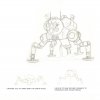AlexanderSen
Cosmic Ghost
- Joined
- Oct 15, 2013
- Messages
- 200
I have been lazy lately, playing Fortnite and sleeping in during my days off, but I was mulling over some designs I had for some Rescue Mecha(s). I drew inspiration from the Patlabor and Thunderbirds 2086 series. The anime Thunderbirds 2086 was one of my favorite shows when I was a kid, so I always wanted to design my own versions of rescue mechs and vehicles.
The first of these designs are for an land/ground based All Terrain Search and Rescue Mecha. I did some rough sketches of my ideas.

These designs had to have these prerequisites and features:
1) An advanced sensor system - the vehicle would be loaded with sensors such as infrared thermo-optics, high bandwidth radio, and a satellite GPS up-link to help with search efforts.
2) Better visibility with a wide open cockpit cabin and a 360 degree observer spotting dome on top of the vehicle for a better view of terrain
3) Flood lights for night work
4) A wire crane tow and tow hooks to pull, carry, and or haul loads
5) A full compliment of search and rescue equipment including first aid, stretchers for carrying wounded, and an easy access / loading mechanism for the stretchers with injured into the vehicle. Space for shovels, tools, climbing harnesses, ropes, hooks, and other gear that is needed for emergency rescues.
7) Hazmat and environmental powered suits and as well a docking unit for a humanoid robot / cyborg or a small drone - used in extreme conditions where the environment is too hazardous for regular humans. Used get into hard to reach places as well as hazardous environments such as in a burning building, radioactive contaminated areas, or avalanche rock slide zone.
8) Ability to transverse rough terrain. In regards to this I am still trying to figure out how the legs work. I have been doing research, looking at solutions from things that have a similar problem like public transport, and playing with the idea of lowering knelling chassis for easier access to load injured patients into the vehicle. The challenge is that at the same time on a Multi legged AT Mecha ground clearance is an issue. These type of mechs need higher clearance at the base of the walker to clear rough terrain is needed to transverse rough terrain but then if it is higher off the ground there is an issue of access when loading the injured and rescued which must get in to the vehicle some how.
With the ATRV/ATRM (All Terrain Rescue Vehicle/Mech) I was looking at different types of leg/joints and types of locomotion:
I) Mountain Goats and pack animals such as Camel/Mule/Horse
II) Spider and Insect legs
III) Humanoid Bipedal gait - Gorilla, Monkeys, and Humans
I hammered out two bigger more detailed sketches for the ideas I liked and the direction I thought it should go.


The first of these designs are for an land/ground based All Terrain Search and Rescue Mecha. I did some rough sketches of my ideas.

These designs had to have these prerequisites and features:
1) An advanced sensor system - the vehicle would be loaded with sensors such as infrared thermo-optics, high bandwidth radio, and a satellite GPS up-link to help with search efforts.
2) Better visibility with a wide open cockpit cabin and a 360 degree observer spotting dome on top of the vehicle for a better view of terrain
3) Flood lights for night work
4) A wire crane tow and tow hooks to pull, carry, and or haul loads
5) A full compliment of search and rescue equipment including first aid, stretchers for carrying wounded, and an easy access / loading mechanism for the stretchers with injured into the vehicle. Space for shovels, tools, climbing harnesses, ropes, hooks, and other gear that is needed for emergency rescues.
7) Hazmat and environmental powered suits and as well a docking unit for a humanoid robot / cyborg or a small drone - used in extreme conditions where the environment is too hazardous for regular humans. Used get into hard to reach places as well as hazardous environments such as in a burning building, radioactive contaminated areas, or avalanche rock slide zone.
8) Ability to transverse rough terrain. In regards to this I am still trying to figure out how the legs work. I have been doing research, looking at solutions from things that have a similar problem like public transport, and playing with the idea of lowering knelling chassis for easier access to load injured patients into the vehicle. The challenge is that at the same time on a Multi legged AT Mecha ground clearance is an issue. These type of mechs need higher clearance at the base of the walker to clear rough terrain is needed to transverse rough terrain but then if it is higher off the ground there is an issue of access when loading the injured and rescued which must get in to the vehicle some how.
With the ATRV/ATRM (All Terrain Rescue Vehicle/Mech) I was looking at different types of leg/joints and types of locomotion:
I) Mountain Goats and pack animals such as Camel/Mule/Horse
II) Spider and Insect legs
III) Humanoid Bipedal gait - Gorilla, Monkeys, and Humans
I hammered out two bigger more detailed sketches for the ideas I liked and the direction I thought it should go.









